Where the Olive Future Begins
First published in Sanctuary Asia,
Vol. 39
No. 2,
February 2019
By Arghya Adhikary
Just three and a half hours away from Bhubaneswar is a place where nature unfolds one of its most amazing mysteries. Here the tranquil beaches of Rushikulya come alive with the beating of heavy flippers that belong to hundreds of thousands of olive Ridleys, the smallest sea turtles in the world, that arrive en-masse to lay their eggs on the beaches of coastal Odisha.
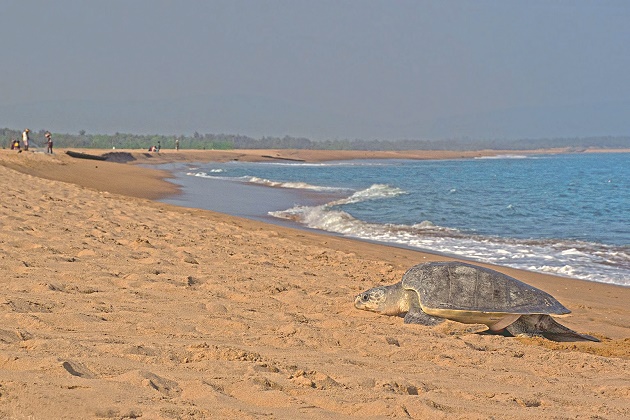
Arribada, the synchronised mass nesting takes place approximately 30 days after the turtles mate. Hundreds of thousands of these ancient beings take over the beach, lay their eggs and return to the sea.
Photo:Arghya Adhikary and Saurabh Chakraborty
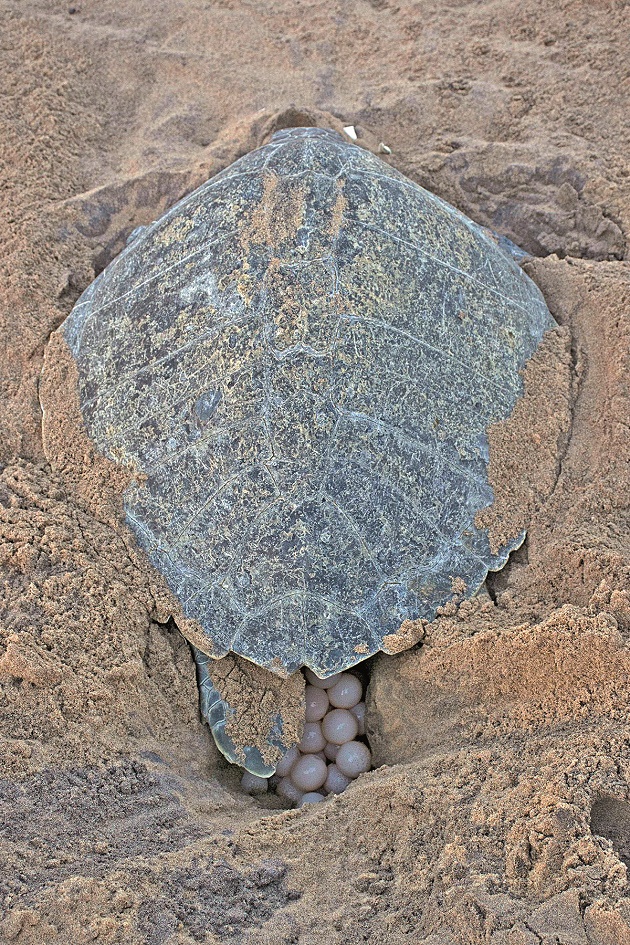
The Backdrop
The plan was not set at all. It was quarter past eleven at night when the phone rang. “Before mass nesting, these turtles congregate in large numbers for mating near the seashore; come as soon as you can,” said Rabi (Rabindranath Sahoo), the head of the Rushikulya Sea Turtle Protection Committee (RSTPC). A quick look at the IRCTC website revealed non-availability of train tickets. But we were determined. We boarded the next available overnight bus from Kolkata to Bhubaneswar.
“Get down at Vani Bihar and take the train from Bhubaneswar to Ganjam, and Magata will receive you there,” Rabi called again. As the train raced away from the hustle and bustle of the city, the colours outside the window transformed to a lush green. Our train sped past the Eastern Ghats, and the ocean-like Chilika lake before reaching Ganjam, where Magata Behra, also with the Rushikulya Sea Turtle Protection Committee, was waiting for us.
And Nature Opened Her Curtain…
The deep blue sea was wild, choppy and daunting, tossing our small boat about. As we crossed the first wave line, a head popped up beside our boat, followed by another and then another. Soon we were surrounded by endangered olive Ridley turtles often surfacing to breathe and bask in the morning sun. Further into the ocean, Magata spotted a mating pair and our cameras went into overdrive.
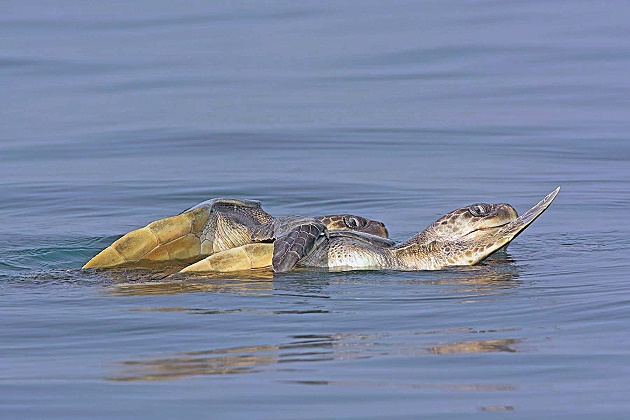
A pair of endangered olive Ridley turtles mates in the ocean, a natural history of phenomenon that only a lucky few get to witness each year.
Photo:Arghya Adhikary and Saurabh Chakraborty
It was a humbling, yet exhilarating experience. We headed back to Kolkata that evening but decided to return after a month to witness the arribada… the arrival of these turtles for mass nesting.
The Phone Rang Again
Exactly 34 days after our Rushikulya visit, we heard from Magata. Soon, we landed up at his village, Puranbandha, which was to be our base for the next two days.
Eager to get to Rushikulya, we were ready to go, but Magata said there would be next to no turtles on the beach. Though the arribada was a nocturnal affair, we nevertheless made our way to the beach and saw some individual creatures on the shore laboriously digging holes in the sand to lay their eggs.
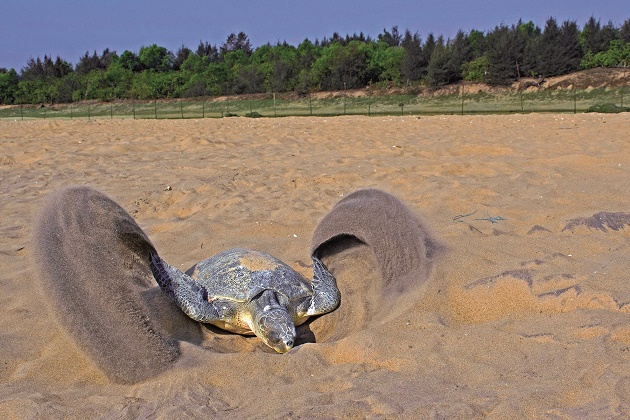
The female olive Ridley turtle lays her eggs in a nest, which she painstakingly digs with her flippers.
Photo:Arghya Adhikary and Saurabh Chakraborty
We were awestruck. We could hardly wait to see what would be in store for us at nightfall.
A Sea of Turtles
When we reached, equipped with dim, red-beam headlamps, so as not to disorient the turtles, the sight before us left us amazed. The sandy beach had vanished under the cover of countless black domes as far as the eye could see. We spoke in hushed, reverential whispers. Thousands of olive Ridley turtles had arrived and hundreds more continued to emerge with every wave that washed upon the shore.
Some of these old-world creatures were digging nests, others returning to the sea after laying their eggs. In silence, we watched as the reptiles, carapaces glistening, hauled themselves out from the sea, propelled by instincts of motherhood. There were barely any empty spots to accommodate the hordes and we watched some literally climb over each other, almost burying the new arrivals. Still more could be seen digging up nests where eggs had already been laid.
Rushikulya had come alive in the dark of the night.
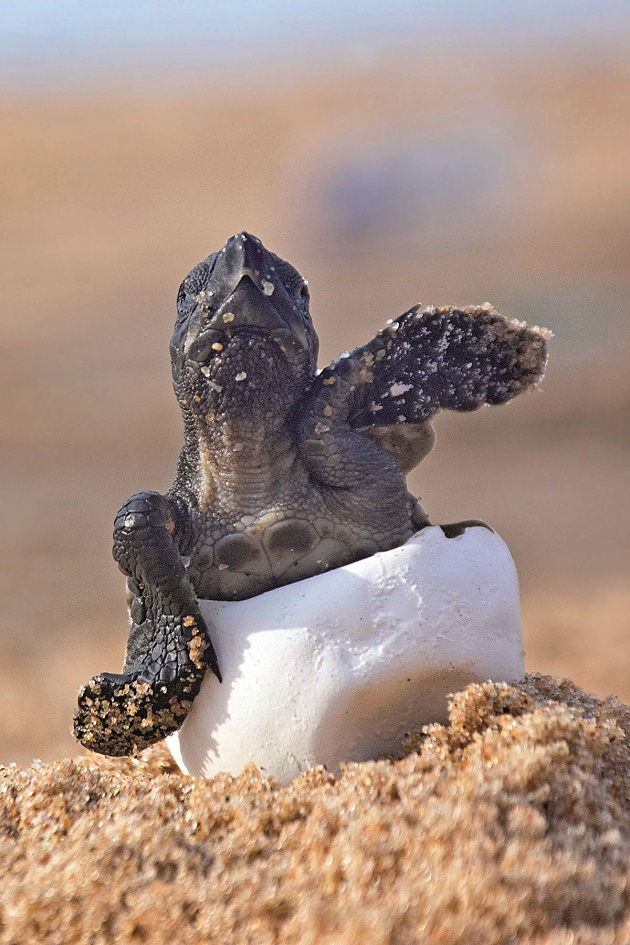
The hatchlings emerge after a period of about 50 days.
Photo:Arghya Adhikary and Saurabh Chakraborty
Just before dawn, the sandy beach began to resurface… with most of the turtles having headed back to the sea. We waited until sunrise, limbs sore from carrying heavy photographic equipment, and walked away from the beach. Tired, but happy and gratified.
The Babies Came Out
Exactly 54 days later, we got the call for which we were anxiously waiting – the hatching had begun. On arrival, we met Jadumoni, Magata’s younger brother, at Ganjam. After depositing our luggage at Puranbandha, we headed straight for the beach.
Nothing prepared us for the heartbreak. Thousands of olive Ridley hatchlings were lying dead or dying on the beach and a mere handful could be seen moving toward the sea. We left, hoping that the situation might get better after dark.
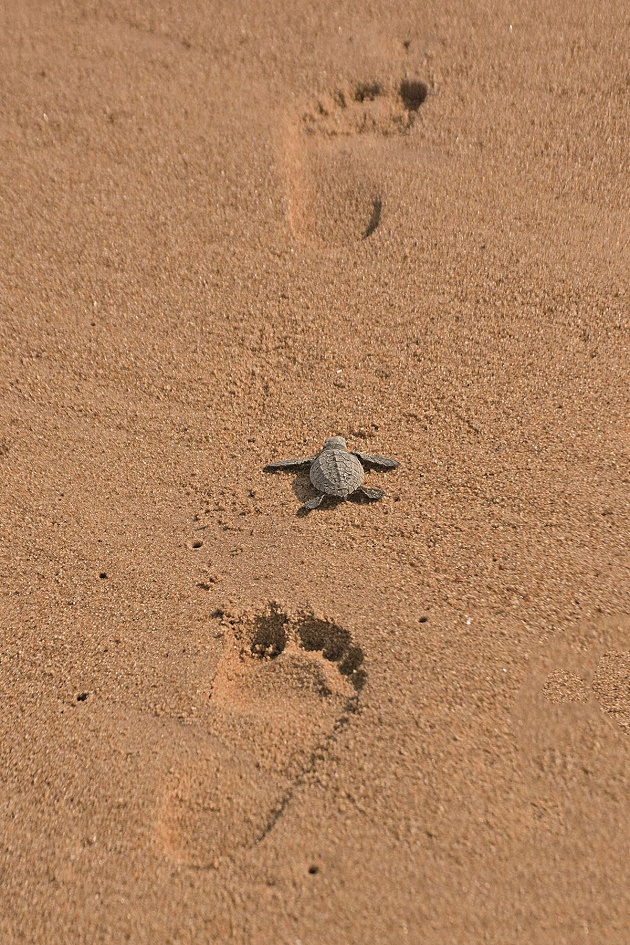
The female olive Ridley turtle lays her eggs in a nest, which she painstakingly digs with her flippers. When the eggs hatch, the beach is filled with hundreds of tiny hatchlings, who navigate their path to reach the water for the first time.
Photo:Arghya Adhikary and Saurabh Chakraborty
.jpg)
True enough, at 3 a.m., our dim red beams revealed thousands of tiny olive Ridley babies making their way towards the sea. In the dark, we also saw jackals, jungle cats, and feral dogs feasting on these minuscule babies. Some were gorging on eggs. There was no cruelty involved. This was nature’s way. During the day, Brahminy Kites, Jungle Crows and gulls were gifted with life-sustaining food.
Nature controls the balance. Given the sheer number of eggs that are laid, despite the huge losses, the species has managed to survive the trials of life over millions of years. By some estimates, only one hatchling, out of a thousand eggs laid, manages to reach the sea and make it to adulthood.
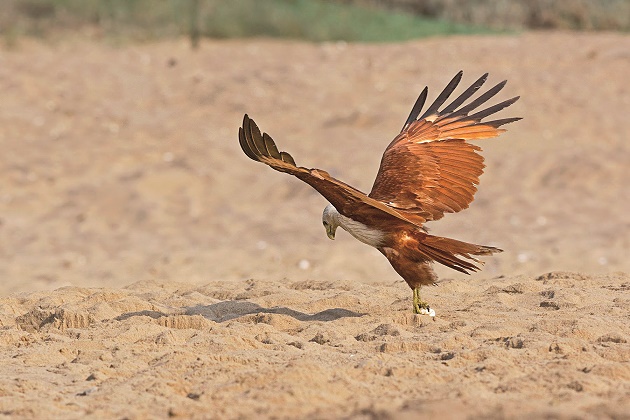
It is estimated that approximately one hatchling in every 1,000, which make it to the sea survives to reach adulthood. Some perish earlier as predators such as Brahminy Kites (above), crabs (below), jungle cats and jackals feed on the eggs and defenceless hatchlings.
Photo:Arghya Adhikary and Saurabh Chakraborty
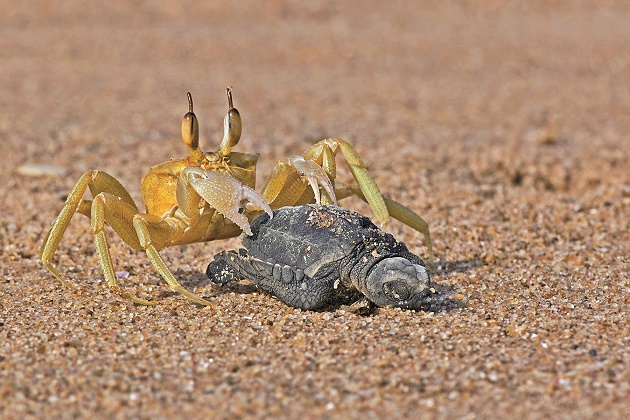
India is a country with a heart. A number of very dedicated organisations work assiduously to protect the turtles, including the Rushikulya Sea Turtle Protection Committee, WWF-India and, of course, the local people of Rushikulya who are proud of the living heritage next to which they live.
Nature Surprises Us
Five days after we returned to Kolkata we got another call. A second wave of mass nesting was underway. We drove straight to the beach and what we witnessed was beyond description. Thousands upon thousands of tiny hatchlings were headed towards the sea, even as hordes of adult females made to the shore to lay their eggs.
Rabi and Magata said that in the late 1980s the same phenomenon had occurred in the Gahirmatha estuary. However, in Rushikulya, there had been just one report that described the extraordinary occurrence some 25 years ago.
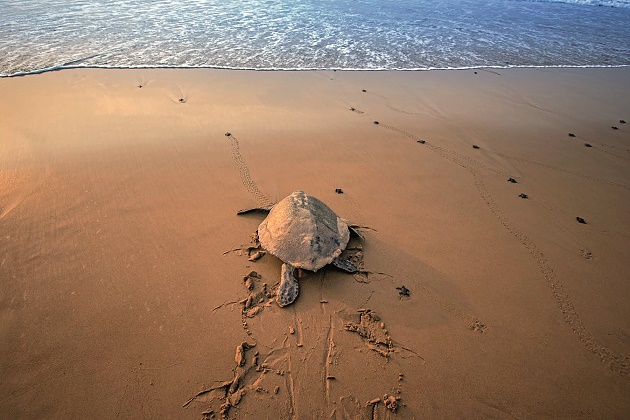
The author witnessed an extremely rare and extraordinary event, which occurred in Rushikulya almost 25 years after it was first reported – mass nesting and mass hatching taking place simultaneously. Hatchlings crawl to the sea accompanied by returning mother turtles.
Photo:Arghya Adhikary and Saurabh Chakraborty
How fortunate we were to witness this natural miracle. We felt both humbled and filled with gratitude for those whose lives are dedicated to studying and protecting the turtles we have come to love. May Rushikulya always remain safe. May the turtles continue their chain uninterrupted, long after Homo sapiens have bid adieu to this incredible biosphere.
Author: Arghya Adhikary








.jpg)


